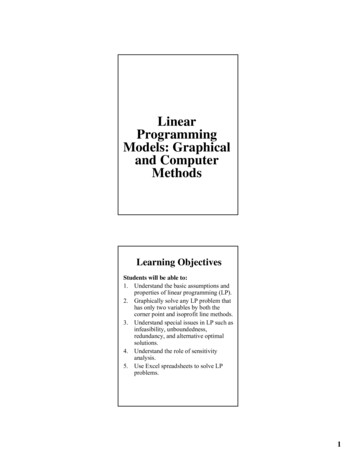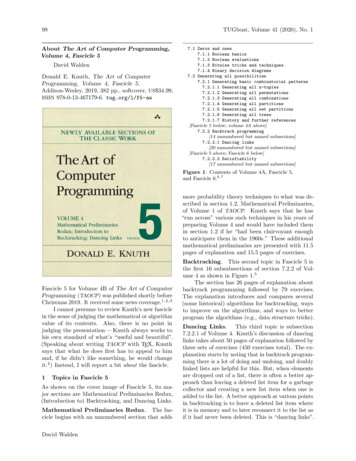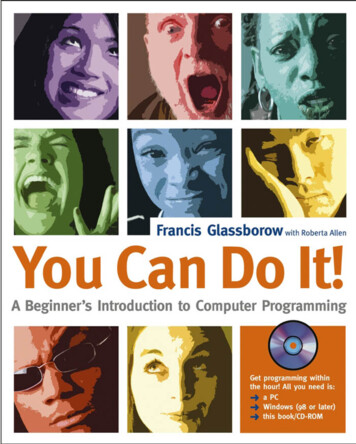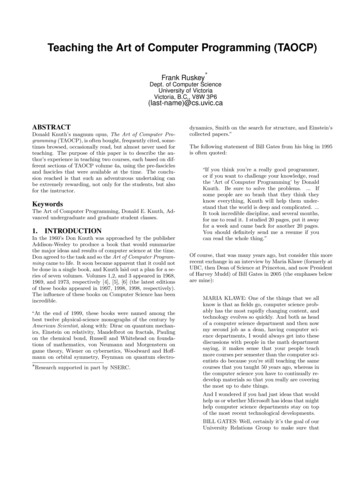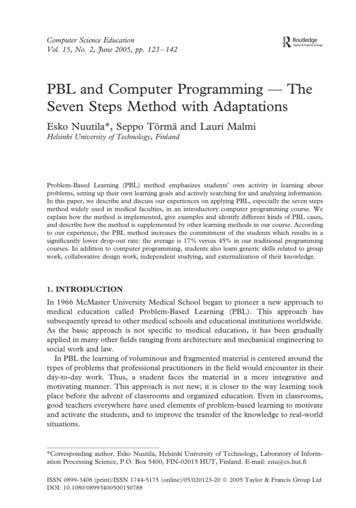
Transcription
Computer Science EducationVol. 15, No. 2, June 2005, pp. 123 – 142PBL and Computer Programming — TheSeven Steps Method with AdaptationsEsko Nuutila*, Seppo Törmä and Lauri MalmiHelsinki University of Technology, FinlandProblem-Based Learning (PBL) method emphasizes students’ own activity in learning aboutproblems, setting up their own learning goals and actively searching for and analyzing information.In this paper, we describe and discuss our experiences on applying PBL, especially the seven stepsmethod widely used in medical faculties, in an introductory computer programming course. Weexplain how the method is implemented, give examples and identify different kinds of PBL cases,and describe how the method is supplemented by other learning methods in our course. Accordingto our experience, the PBL method increases the commitment of the students which results in asignificantly lower drop-out rate: the average is 17% versus 45% in our traditional programmingcourses. In addition to computer programming, students also learn generic skills related to groupwork, collaborative design work, independent studying, and externalization of their knowledge.1. INTRODUCTIONIn 1966 McMaster University Medical School began to pioneer a new approach tomedical education called Problem-Based Learning (PBL). This approach hassubsequently spread to other medical schools and educational institutions worldwide.As the basic approach is not specific to medical education, it has been graduallyapplied in many other fields ranging from architecture and mechanical engineering tosocial work and law.In PBL the learning of voluminous and fragmented material is centered around thetypes of problems that professional practitioners in the field would encounter in theirday-to-day work. Thus, a student faces the material in a more integrative andmotivating manner. This approach is not new; it is closer to the way learning tookplace before the advent of classrooms and organized education. Even in classrooms,good teachers everywhere have used elements of problem-based learning to motivateand activate the students, and to improve the transfer of the knowledge to real-worldsituations.*Corresponding author. Esko Nuutila, Helsinki University of Technology, Laboratory of Information Processing Science, P.O. Box 5400, FIN-02015 HUT, Finland. E-mail: enu@cs.hut.fiISSN 0899-3408 (print)/ISSN 1744-5175 (online)/05/020123-20 ª 2005 Taylor & Francis Group LtdDOI: 10.1080/08993400500150788
124E. Nuutila et al.The effectiveness of PBL has been studied over the years. Norman and Schmidt(1992) review the evidence gathered. They conclude that while there has been noevidence that PBL results in an improvement in the results of standard examinations(or may even slightly lower them), ‘‘it may foster, over periods up to several years,increased retention of knowledge’’, ‘‘may enhance both transfer of concepts to newproblems and integration of basic scientific concepts into clinical problems’’,‘‘enhances intrinsic interest in the subject matter’’, and ‘‘appears to enhance selfdirected learning skills.’’Various specific ways for implementing PBL exist. Schmidt (1983) presents theseven steps method of PBL used at Maastricht University. The specific aims of thismethod is to foster learning by (1) activating the prior knowledge of students about thetopics to learn, (2) connecting the learning to specific problem situations that mightoccur in practice, and (3) making the students to elaborate the material that they havelearned.In this paper we describe our experiences since 1999 of using the seven stepsmethod of PBL in an introductory programming course in Helsinki University ofTechnology. Each year there has been about 30 first-year university students comingfrom the study program of information networks, a multi-disciplinary programcombining information technology, social sciences and business management. Abouthalf of these students are female.The goal of the course is to learn the Java programming language to the extent thatthe students can independently implement non-trivial Java applications (e.g., oneswith a graphical user interface). In our implementation of the seven steps method,students meet once-a-week in groups to discuss real-world cases. The role of a case isto present something that requires explanation or solution, and that will lead the groupto define learning goals. A new case is opened every week and closed next week aftereach member of a group has independently studied to achieve the learning goals. In onesemester students process ten cases, each focusing on some important aspect ofprogramming. The PBL cases and sessions replace the traditional lectures.In our course, PBL is supplemented with other learning methods. Practicalprogramming assignments and a personal programming project form an important part ofthe course. In addition, the students write essays, draw concept maps (Novak & Gowin,1984), and collect all material they have produced in a portfolio.In a questionnaire made in autumn 2002 the students reported that group work inPBL improved the motivation, provided emotional support, and gave a social contextfor the course. A measurable benefit of this learning method has been a drop-out ratemuch lower than in our traditional programming courses, 17% versus 45%. Both thestudents of the PBL course and the students of the traditional programming coursestake subsequently the same advanced course in Java programming. The averagescores for the students coming from the PBL course have been slightly better, but thedifference is not significant.From the teacher’s point of view, the close interaction with the students in the PBLsessions enables rapid identification of difficulties in learning and spotting ofproblems in the course arrangements. Further, the PBL method seems to promote
PBL and Computer Programming125learning of new concepts and mechanisms as well as problem solving and programdesign.PBL is a term that is used for a wide range of practical teaching approaches, and therole of the problems varies in these approaches. Firstly, according to (Schmidt, 1983)PBL refers to learning that is stimulated by descriptions of real-world problems.Students do not necessarily try to solve a problem but rather define learning goals tobetter understand it. Our PBL course is primarily based on this approach. Secondly,PBL is often used to mean a learning method in which students solve practicalproblems and the learning happens as a side effect of the solution process. This hasalso been called problem-oriented learning. Thirdly, when the size of the problemsbecomes larger, the approach becomes project-based learning.Other applications of PBL in computer science courses have been reported in theliterature. In the University of Sydney, foundation CS courses have beenimplemented with an approach that consists of two project like cases per semester(Fekete, 1998; Greening, 1997; Kay et al., 2000). The authors define PBL as‘‘learning by solving a large, real-world problem.’’ In Linkoping University PBL hasbeen used in a course that integrates computer science studies with other engineeringdisciplines (Lambrix, 1998). This course is based on a single large scenario that isprocessed through four major themes. The role of problems in these courses differsfrom that in our course; in our classification these approaches fall more in thecategory of problem-oriented or project-based learning. However, similar benefits arereported: learning generic skills, familiarity with group work, and ability to deal withvaguely specified problems.In Section 2 we present the PBL method and how we have implemented it on ourcourse. We give examples of PBL cases that we have used. In Section 3 we list theobservations we have made during different versions of the PBL course between 1999and 2003. In Section 4 we present the other learning methods that were used inaddition to the PBL method. Finally, we discuss the pros and cons of the method inSection 5 and identify such elements of programming skill that are well supportedwith the PBL method, as well as such elements which require different learningmethods. The Appendix contains the full list of cases and the programmingassignments we have used in our course.2. IMPLEMENTATIONIn this section, we describe the use of PBL in our programming course. We start bygiving a short overview of the course and the variety of learning methods used inaddition to PBL. Then we describe the PBL method in detail and give examples ofPBL cases used.2.1. Course OverviewThe course is meant for first year university students, who have no previousprogramming experience. The goal of the course is that the students learn basic
126E. Nuutila et al.object-oriented programming in the Java language and are able to independentlyconstruct Java applications with graphical user interfaces.Traditionally, a series of lectures has created the structure and rhythm for learningin our programming courses. The conceptual and factual content of a programminglanguage, and elements of the programming skill are presented in the lectures. In thiscourse, the PBL cases have a similar role. The course includes ten different PBLcases, approximately one case per week.Since programming is a skill, it needs to be rehearsed. Thus, already in the firstcourse version (autumn 1999) we supplemented the PBL cases with programmingassignments and a personal programming project. Solving the programmingassignments is supported by weekly meetings with the course assistants.In addition, students write essays and draw concept maps about key mechanisms ofthe programming language. Based on the material they have produced in these tasks,they finally prepare a portfolio, in which they summarize and reflect their learning.The students are evaluated based on the programming assignments, the programming project, an exam, and the portfolio.As the reader can guess, we do not believe PBL to be a magic solution forlearning programming. However, PBL has a more central role than other learningmethods mentioned above. It is the main organizing method in the course, andthe weekly PBL sessions establish a social organization among the students andthe teachers. We explain the motivation and the role of the other learning methodsbelow.2.2. PBL: The Seven Steps MethodSeveral concrete implementations of PBL exist. We have adapted our method fromthe seven steps method described in (Schmidt, 1983).The students are divided into groups of 7 – 10 persons. Each PBL group issupervised by a tutor, whose primary role is to act as a domain expert, and thesecondary role is to be a facilitator of the group process. The tutors are either facultymembers or students who have taken the same PBL course earlier.The tutor is mainly passive during the PBL session but is ready to answer anyquestions. However, if the discussion of the group takes a wrong track or if clearlyfalse conceptions start to dominate, the tutor should correct the situation, forinstance, with appropriate questions. If the activity in the group is unbalanced orunproductive, the tutor tries to improve the behavior of the group. Our experiencesuggests that if the tutor becomes too active, the PBL session starts to resemble alecture, and the students begin to see the tutor as responsible for their learning.Each PBL group meets once a week in a three hours PBL session. A group needs ameeting room equipped with a white board or a flip chart. Self-stick notes and whiteboard markers are also provided for all students.The meeting starts with the closing session of the previous case, if any. Then a newcase is opened. The processing of the case goes through the sequence of steps shownin Figure 1.
PBL and Computer Programming127Steps 1 and 2, examination of the case and identification of the problem, arestraightforward. Only in the first few cases the students may have difficulties in findinga title for the case. The tutor may tell that the wittiness of the title is not important.In step 3, brainstorming, the goal is to connect the case with the previousknowledge and experience of the students. It is essential that the students do notcriticize each others — or their own — ideas. In fruitful brainstorming there areparallel and freely combining streams of ideas. In our experience, brainstorming isusually the least problematic step of the method.Step 4, sketching of an explanatory model, has been less satisfying. The studentsusually confine themselves to regrouping the self-stick notes on the white board.Seldom any significant structural or conceptual reorganization of the material takesFigure 1. The sequence of steps used to process each case
128E. Nuutila et al.place. Recently, we have experimented with concept maps in sketching the model. Theresults have been encouraging: new abstractions and relationships emerge among theideas and less fruitful ideas are left out. It is worth studying whether the tutor couldtake a more active role in guiding the sketching process. It is important, however, thatthe group, and not the tutor, provides the content of the explanatory model, since itshould reveal what weaknesses or gaps there are in the current understanding.In step 5, establishing the learning goals, the tutor should encourage the students tomake the learning goals as precise and concrete as possible. Generally, the studentsare able to identify relatively good learning goals but often look for the tutor’sapproval for the goals. Finally, the group should identify material for independentstudying (books, articles, and web sites), a task where the tutor can help.Step 6, independent studying period, is the most crucial of the steps. If the studentsfail to study enough, the PBL method does not work. The importance of self studyshould be emphasized to the students from the beginning and the morale should bekept high throughout the course. In addition, this should be taken into account whendesigning the syllabus. There should be eno
seven steps method of PBL used at Maastricht University. The specific aims of this method is to foster learning by (1) activating the prior knowledge of students about the topics to learn, (2) connecting the learning to specific problem situations that might occur in practice, and (3) making the students to elaborate the material that they have


